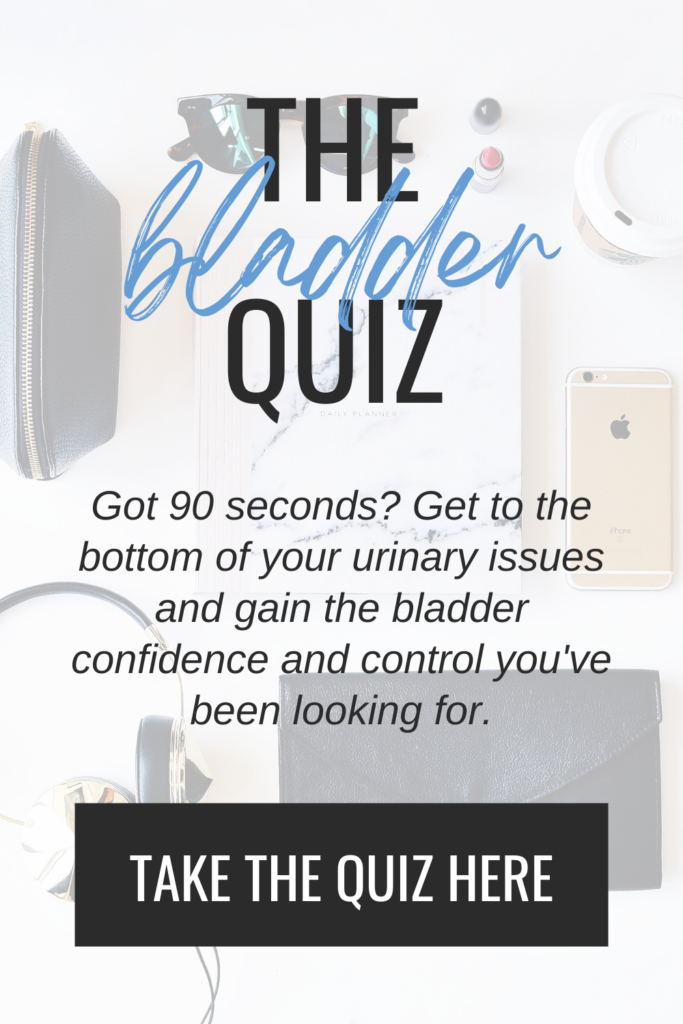I’m not a fan of cookie-cutter medical advice or broad, ambiguous health statements, but we can all agree that drink water, eat protein, get enough sleep, move your body, and relax your pelvic floor (*wink wink*) are worthy and worthwhile words of wisdom that 99% of the population would…should…could subscribe to. But I’d like to propose adding juuuuuuust one more preventative & proactive & palliative checkbox to the list that ~literally~ everyone would benefit from. (Super dramatic drumroll please)…deep core strengthening.
RELATED POST: Your Day Starts at Bedtime: 25 Easy Habits for a Better Night’s Sleep
RELATED POST: My Daily Pelvic Floor Relaxation Routine & Why You Might Want to Try It Too
Now this blog post isn’t about weight loss, six-pack abs, or fitting back into your jeans from high school (although I hear low-rise are back in!?), so if that’s why you clickety-clicked your way here…I hate to break it to ya…but you’ll be disappointed. Unfortunately there are no magic exercises (that I know of) to shrink your waist, and I’ve personally found the “abs are made in the kitchen” statement to be annoyingly true.
Instead, I want to tell you about a muscle in the body that you NEED to know about – one that can single-handedly improve your posture and pelvic floor dysfunction, prevent back pain and injuries, and make pregnancy and postpartum significantly smoother. If I had a stage, microphone, and captive audience, I would first use the opportunity to educate on 1) why most people have a tight pelvic floor and 2) how to relax it. Then if I had five minutes to spare, [this] information on deep core strengthening is what I would share next.
RELATED POST: 19 Reasons You Have a Tight Pelvic Floor (Plus What to Do About It)
A little anatomy lesson
There are four layers of core muscles in the human body, and listed from superficial to deep they include the rectus abdominis (six pack muscle that performs a crunch), external & internal obliques (which control trunk rotation and side-bending), and transverse abdominis (the star of today’s show). All of these muscles attach at the ribs, spine, and pelvis to move and support the trunk, assist in breathing, and control abdominal pressure for digestion, urination, and defecation.
The fibers of the transverse abdominis (TRA) travel horizontally across the body. They start at one side of the spine, wrap across the middle, and attach to the other side of the spine. Unlike the other three core muscles listed above, the TRA performs no trunk movement when contracted…its entire role is to act like a built-in back brace and provide control and stability to the structures above, below, and under it (i.e. – theeeeee entire rest of the body).
The many benefits of deep core strengthening (aka – why you should keep reading ;))
When choosing a blog post topic, I don’t (always) decide based on what sounds fun to write, what would rank me higher with the Google gods, or what my audience is asking for. Rather, most of the time I simply want a resource for the advice I find myself teaching on repeat in the clinic or during my virtual one-on-one consults, and deep core strengthening is one that gets brought up with nearly every patient, pelvic health and beyond. In other words, this is basically a free physical therapy session…you’re welcome!
BYE BYE BACK & HIP PAIN
Whether you have chronic back and hip pain, it only occasionally flares up, or you want to prevent it from ever starting in the first place, deep core strengthening should definitely be on your to-do list. Because the TRA attaches to the spine and pelvis, it’s the muscle that controls those structures with any and all movement. If the TRA is not engaged or strong enough to support the activity, other muscles compensate, joints wear down, and pain ultimately results.
RELATED POST: You Might Be Overlooking [These] 10 Exercise Benefits
PELVIC HEALTH & FUNCTION
The TRA is directly connected to the pelvic floor, and they not only work together to do…well…everything, but they also greatly affect each other. This is good news because it means we can positively influence pelvic floor function, strength, coordination, and control with the strategies found here, no kegels necessary! But it also means deep core weakness can cause pelvic floor compensation and tightness (which results in pelvic pain, pain with sex, constipation, urinary urgency & hesitancy) or carry over to pelvic floor weakness (which looks like leakage and prolapse).
DIASTASIS PREVENTION & TREATMENT
Diastasis is the abdominal separation that primarily takes place during pregnancy as the female body accommodates a growing baby. While every woman develops a diastasis by the third trimester, not every mama experiences one postpartum. Because diastasis only widens the midline of the rectus abdominis (the most superficial core layer), the TRA remains completely intact and ultimately able to aid in closing a diastasis. Therefore, deep core strengthening during the pre-conception, pregnancy, and postpartum periods is the number one way to prevent and treat a diastasis.
RELATED POST: 6 Steps to a Proactive Pregnancy: My Top Tips for Pain, Birthing, & Postpartum Healing
RELATED POST: Postpartum is Forever: Here’s Why & How to Settle Into Your New Normal
POSTURE, BREATHING & DIGESTION
Every body has an ideal state of homeostasis or “normal”, and when it comes to easily overlooked but overall essential things like posture, breathing, and digestion, the TRA is a main player. Every breath we take, the TRA is moving. Every position we assume, the TRA is assisting in spinal and pelvic posture. Every meal we eat, the TRA is regulating abdominal pressure for digestion. And when the TRA has adequate strength and endurance, all of the above will take place far more effectively and efficiently.
RELATED POST: The Importance (& Power) of Posture for Pelvic Health
How to engage & strengthen your deep core
Now that you know TRA anatomy and the benefits of deep core strengthening, it’s time to make the magic happen! And like most strategies I teach, this follows my beloved “less is more” approach to health and wellness – no equipment, minimal time, and mindful energy required. Below you’ll find step-by-step directions for engaging the TRA, but this free guide has the instructions and exercises you need to progress it from there.
HOW TO ENGAGE THE TRA
1. Begin by laying on your back, knees bent and feet flat on the ground. This places you in neutral pelvic posture, which is ideal for the TRA.
2. Find the pointy bones on the front of your hips/pelvis and place your fingers just inside of them towards your belly button.
3. Just like the TRA muscle fibers travel horizontally from hip bone to hip bone, picture a string running across your abdomen between your fingers.
4. As you exhale, engage your deep core muscles like you are lightly pulling your hands and hip bones together by that string. (This is not sucking in or bulging out…it’s bracing and drawing together.)
5. Hold that TRA contraction for 5-10 seconds while you inhale and exhale.
6. When you relax the TRA, it should feel like your fingers are ever so slightly falling back out to the sides. If you feel this, you will know you did it correctly.
7. Once you can perform this laying down, try it in sitting and then standing, all with focus on posture and breath. Once you can activate the TRA in isolation, begin incorporating it into your daily activities.
8. Picture the TRA like a dial, not a light switch. Rather than turning it on or off, all or nothing, you can engage it from 5% (laying there practicing this technique) to 50% (lifting your baby) to 100% (during core exercises) and everywhere in-between.
Turn any movement into a deep core workout
Isolating the TRA and specifically strengthening it with the exercises in this free guide are helpful & worthwhile & lovely, but using that muscle in your everyday and regular exercise routine is ultimately how to gain the benefits above. As your confidence in performing a TRA contraction improves, the next step is to intentionally tune into it at any and every opportunity and watch as it gets easier and easier with time.
MINDFULNESS WITH EXERCISE
I don’t care if you like cycling or calisthenics, walking or weight lifting, pilates or plyometrics, the elliptical or elastic bands…turning on your TRA during exercise is a full stop, hands down MUST. Not only will you limit pain and prevent injury, but the power and performance behind whatever you’re doing will instantly increase as your body gets the support it needs. While most of us are multi-tasking mavens, remembering the deep core while counting reps or drowning in sweat isn’t always easy. Here are the tricks I personally implement to make it happen –
Slow down. I can 1000000% appreciate and relate to the early morning workout rush, but slowing down to focus on HOW your body is moving is the best first step. Find things that remind you to check in with your deep core mid-movement – every five repetitions, the start of a new song, reaching the next intersection – and that split second pause will become more realistic.
Use a mirror. Yep…I’m encouraging you to channel your inner bro and hog the mirror. When able to watch yourself, you’re more likely to catch if your TRA is not engaged. Thankfully most gyms and studios have mirror space a plenty, but if you workout at home, purchasing a moveable & mountable & storeable (& cute) full-length mirror is a simple solution.
Take yo’ shirt off. I don’t know about you, but I’m wayyyyyyy more likely to focus on my core if the rest of the world can see it too. Anytime I do an activity that necessitates core engagement, I wear a crop top or sports bra only as a visual (remember that mirror?) and mental signal to sustain that deep core contraction.
Breathe. The TRA automatically engages during exhale with proper breathing, so it’s important to breathe out during the hard part of a movement to promote deep core strength. It can take some patience to perfect this, but with practice it will eventually become normal and natural.
Beyond how you move, awareness of activities that especially active the TRA allows you to turn just about any workout into one that promotes deep core strength. Adding a load to any movement, lifting or holding that weight overhead or to one side, single leg, altered base of support, and balance challenges are all effective. Even if you don’t have time for a daily core workout, nearly any movement can check the deep core strengthening box with intention and imagination.
EVERYDAY AWARENESS
Deep core strengthening isn’t just for the gym. In fact, I’d argue that engaging the TRA in your everyday with mindfulness is where the real magic’s made. It’s in how you pick up your baby, carry the groceries, stand at the sink, bend over in the garden, get out of bed, [insert LITERALLY. EVERY.SINGLE. movement here], because the body needs and uses support in each of those activities too. Will you remember to turn on your TRA every time? Ummmmmm…no. But the more you practice, the more second nature it will become. And if you’re really listening to your body – the bone creaks, muscle aches, and pelvic pressure – she will remind you too.
I’m absolutely giddy for you to get going!
This morning when I was working out…I thought of you. Then as I grabbed my wiggly toddler out of bed and carried her downstairs…I thought of you again. And the idea of you implementing deep core strengthening right alongside me with the tips and tools shared here puts a smile on my face because I know you will move better, feel stronger, and have more confidence in your body’s abilities with this simple but sustainable addition to your wellness routine. When it comes to health, I live for actionable advice with real results, and we can definitely add this one to the list.
– Amanda
Disclaimer: The content provided here does not constitute medical advice, nor is it a substitute for personalized healthcare. I’m a doctor, but I’m not your doctor. If you have concerns about a medical condition, diagnosis, or treatment, you should consult with a licensed healthcare professional.
Disclosure: Some of the links above are affiliate links, meaning, at no additional cost to you, I will earn a commission if you click through and make a purchase. No pressure, but I have a feeling you’re gonna like what I’ve taken the time to put my recommendation behind.



















